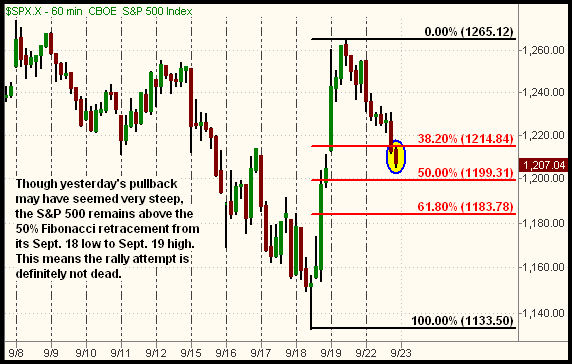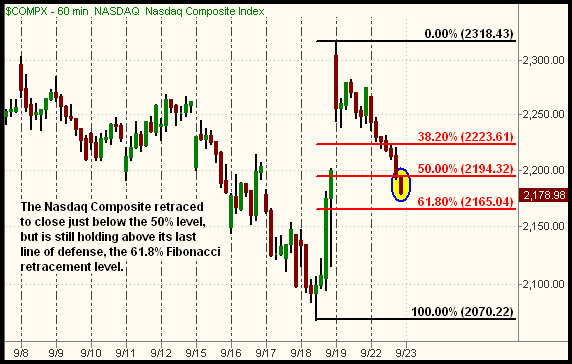|
The Wagner Daily ETF Report For September 23
It was not surprising that stocks retraced some of their huge gains of the preceding two days, but the extent of yesterday's sharp pullback was undoubtedly more than the bulls wanted to see. After opening near the flat line, the major indices trended steadily lower throughout the entire session. The Dow Jones Industrial Average shed 3.3%, the S&P 500 3.8%, and the Nasdaq Composite 4.2%. Small and mid-cap stocks, which showed the most relative strength during the recent rally, sold off the most. The Russell 2000 and S&P Midcap 400 indices lost 4.4% and 4.7% respectively. All the main stock market indexes closed at their intraday lows.
One positive of yesterday's session is that turnover receded substantially. Total volume in the NYSE decreased 53% below last Friday's frantic pace, while volume in the Nasdaq ticked 51% lower. Trading in the previous session was inflated by "quadruple witching" options expiration day, but yesterday's volume in both exchanges was still so light that it fell below 50-day average levels for the first time in two weeks. Although the percentage losses in the stock market were large, the sharply lower volume tells us institutions were not running for the exit doors. Declining volume in the NYSE exceeded advancing volume by a margin of 4 to 1. The Nasdaq adv/dec ratio was negative by nearly 6 to 1.
In yesterday morning's Wagner Daily, we said the following, "Over the next several days, we would like to see the main stock market indexes gently retrace some of their recent gains, or at least consolidate in a tight, sideways range. Such price action would cause "bull flag" patterns to form on their daily charts. If that occurs, we would also expect some new bullish ETF chart patterns to emerge." Given that the major indices rallied more than 8% in the preceding two days, a pullback of 1% to 2% would have been considered "gentle." However, yesterday's losses in the S&P 500 and Dow Jones Industrial Average caused both indexes to surrender all of last Friday's gains. The Nasdaq Composite fared even worse, erasing all of the previous day's gain and nearly 1% more.
Despite yesterday's sell-off, it's definitely too early to say the rally attempt off last week's lows is dead. Measuring the depth of the pullback, from the intraday low of September 18 to the intraday high of September 19, the main stock market indexes retraced to just above or below the 50% Fibonacci retracement level. This is shown on the short-term hourly charts of the S&P 500 and Nasdaq Composite below:


In "typical" market conditions, a 50% pullback off the high of a short-term rally often would actually provide a positive reward/risk ratio for buy entry, and we would cautiously enter the long side of a broad-based ETF or two. Then, if the retracement violates the 61.8% level, we would quickly close the position(s) for a small loss, as such a move would significantly increase the odds of a complete trend reversal back to test the lows. However, the operative word in this paragraph is "typical," as we are sure you'd agree the current market conditions are anything but "typical!" In these unprecedented times, the very backbone of the U.S. financial system is changing before our eyes, causing the major indices to whipsaw back and forth in average trading ranges of 3 to 5% from day-to-day.
Honestly, we're simply not interested in jumping back into the stock market until we see the development of a trend that can last for more than a day. This may happen as soon as Congress and the Federal Reserve Board come to terms on details of the new bailout package for financial institutions. When/if that happens, we want to already be prepared for the best new ETF trade entries. As such, we spent several hours scanning the charts of more than 300 ETFs last night, but the bad news is we really didn't see any patterns that got us excited.
On the long side, our two favorite patterns for entry are: 1.) Buying the breakout above a tight base of consolidation 2.) Buying the pullback to support of a steadily uptrending ETF. Unfortunately, neither of these patterns can be found right now. What we did find, however, were hundreds of ETFs that have been violently spiking in both directions over the past week -- a flip of the coin could just as easily predict the next day's direction. It's a bit of a stretch, but the best patterns we came across were a few sector ETFs within close proximity of breaking out above their intermediate-term downtrend lines.
Basic Materials (XLB) and Energy (XLE, IYE) are two industries we're keeping an eye on, as they could soon break out above their downtrend lines. Still, we're not overly impressed. The small-cap Russell 2000 (IWM, UWM) showed incredible strength on September 18 and 19, and yesterday's 50% pullback to the 50/200-day MA is attractive, but trading in any of the broad-based ETFs right now should only be attempted by advanced traders who are comfortable with extremely high volatility. Regular subscribers should note our detailed entry, stop, and target price for UWM below.
Presently, we remain fully in cash, observing the recent insanity from the sidelines. Never forget that cash is always a valid position, especially in times such as these. We will happily and patiently stay in capital preservation mode until the market gives us a cue to do otherwise. Doing so enables us to retain our hard earned profits from earlier in the quarter. Remember to trade what you see, not what you think!
Open ETF positions:
Long - (none)
Short - (none)
Deron Wagner is the Founder and Head Trader of both Morpheus Capital LP, a U.S. hedge fund, and Morpheus Trading Group, a trader education firm launched in 2001 that provides daily technical analysis of the leading ETFs and stocks. For a free trial to the full version of The Wagner Daily or to learn about Wagner's other services, visit MorpheusTrading.com or send an e-mail to deron@morpheustrading.com.
|